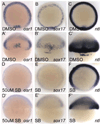Odd skipped related 1 is a negative feedback regulator of nodal-induced endoderm development
- PMID: 25233796
- PMCID: PMC4278437
- DOI: 10.1002/dvdy.24191
Odd skipped related 1 is a negative feedback regulator of nodal-induced endoderm development
Abstract
Background: Early embryo patterning is orchestrated by tightly regulated morphogen gradients. The Nodal morphogen patterns the mesendoderm, giving rise to all endoderm and head and trunk mesoderm. High Nodal concentrations favor endoderm differentiation while lower promote mesoderm differentiation. Nodal signaling is controlled by both positive and negative feedback regulation to ensure robust developmental patterning.
Results: Here we identify odd skipped related 1 (osr1), a zinc finger transcription factor, as a new element in Nodal feedback regulation affecting endoderm development. We show that osr1 expression in zebrafish germ ring mesendoderm requires Nodal signaling; osr1 expression was lost in embryos lacking Nodal signaling. Conversely, osr1 expression was ectopically induced by the activation of Nodal signaling. Furthermore we demonstrate that osr1 responds directly to Nodal signaling. Additionally, osr1 knockdown generated excess endoderm cells marked by sox32 expression while expression of osr1 mRNA was not affected in sox32-deficient embryos.
Conclusions: Our findings identify osr1 as a Nodal-induced, negative feedback regulator of Nodal signaling that acts at the earliest stages of endoderm differentiation to limit the number of endoderm progenitors. As such, we propose that osr1 represents a novel network motif controlling the output of Nodal signaling to regulate mesendoderm patterning.
Keywords: endoderm development; nodal; odd skipped related 1; osr1.
© 2014 Wiley Periodicals, Inc.
Figures







Similar articles
-
odd skipped related1 reveals a novel role for endoderm in regulating kidney versus vascular cell fate.Development. 2008 Oct;135(20):3355-67. doi: 10.1242/dev.022830. Epub 2008 Sep 11. Development. 2008. PMID: 18787069 Free PMC article.
-
Maternal Eomesodermin regulates zygotic nodal gene expression for mesendoderm induction in zebrafish embryos.J Mol Cell Biol. 2014 Aug;6(4):272-85. doi: 10.1093/jmcb/mju028. Epub 2014 Jun 12. J Mol Cell Biol. 2014. PMID: 24924767
-
Nodal patterning without Lefty inhibitory feedback is functional but fragile.Elife. 2017 Dec 7;6:e28785. doi: 10.7554/eLife.28785. Elife. 2017. PMID: 29215332 Free PMC article.
-
Molecular regulation of Nodal signaling during mesendoderm formation.Acta Biochim Biophys Sin (Shanghai). 2018 Jan 1;50(1):74-81. doi: 10.1093/abbs/gmx128. Acta Biochim Biophys Sin (Shanghai). 2018. PMID: 29206913 Review.
-
Patterning of the zebrafish embryo by nodal signals.Curr Top Dev Biol. 2003;55:143-71. doi: 10.1016/s0070-2153(03)01003-2. Curr Top Dev Biol. 2003. PMID: 12959195 Review. No abstract available.
Cited by
-
Temporal and spatial requirements for Nodal-induced anterior mesendoderm and mesoderm in anterior neurulation.Genesis. 2016 Jan;54(1):3-18. doi: 10.1002/dvg.22908. Epub 2016 Jan 12. Genesis. 2016. PMID: 26528772 Free PMC article.
-
OSR1 is a novel epigenetic silenced tumor suppressor regulating invasion and proliferation in renal cell carcinoma.Oncotarget. 2017 May 2;8(18):30008-30018. doi: 10.18632/oncotarget.15611. Oncotarget. 2017. PMID: 28404905 Free PMC article.
-
osr1 Maintains Renal Progenitors and Regulates Podocyte Development by Promoting wnt2ba via the Antagonism of hand2.Biomedicines. 2022 Nov 9;10(11):2868. doi: 10.3390/biomedicines10112868. Biomedicines. 2022. PMID: 36359386 Free PMC article.
-
Reduced expression of odd-skipped related transcription factor 1 promotes proliferation and invasion of breast cancer cells and indicates poor patient prognosis.Oncol Lett. 2020 Sep;20(3):2946-2954. doi: 10.3892/ol.2020.11820. Epub 2020 Jul 7. Oncol Lett. 2020. PMID: 32782611 Free PMC article.
-
Hand2 inhibits kidney specification while promoting vein formation within the posterior mesoderm.Elife. 2016 Nov 2;5:e19941. doi: 10.7554/eLife.19941. Elife. 2016. PMID: 27805568 Free PMC article.
References
-
- Alexander J, Rothenberg M, Henry GL, Stainier DY. casanova plays an early and essential role in endoderm formation in zebrafish. Developmental Biology. 1999a;215:343–357. - PubMed
-
- Alexander J, Rothenberg M, Henry GL, Stainier DY. casanova plays an early and essential role in endoderm formation in zebrafish. Dev Biol. 1999b;215:343–357. - PubMed
-
- Alexander J, Stainier DY. A molecular pathway leading to endoderm formation in zebrafish. Curr Biol. 1999;9:1147–1157. - PubMed
-
- Aoki TO, David NB, Minchiotti G, Saint-Etienne L, Dickmeis T, Persico GM, Strahle U, Mourrain P, Rosa FM. Molecular integration of casanova in the Nodal signalling pathway controlling endoderm formation. Development. 2002;129:275–286. - PubMed
-
- Chen Y, Schier AF. The zebrafish Nodal signal Squint functions as a morphogen. Nature. 2001;411:607–610. - PubMed
Publication types
MeSH terms
Substances
Grants and funding
LinkOut - more resources
Full Text Sources
Other Literature Sources
Molecular Biology Databases
Research Materials

